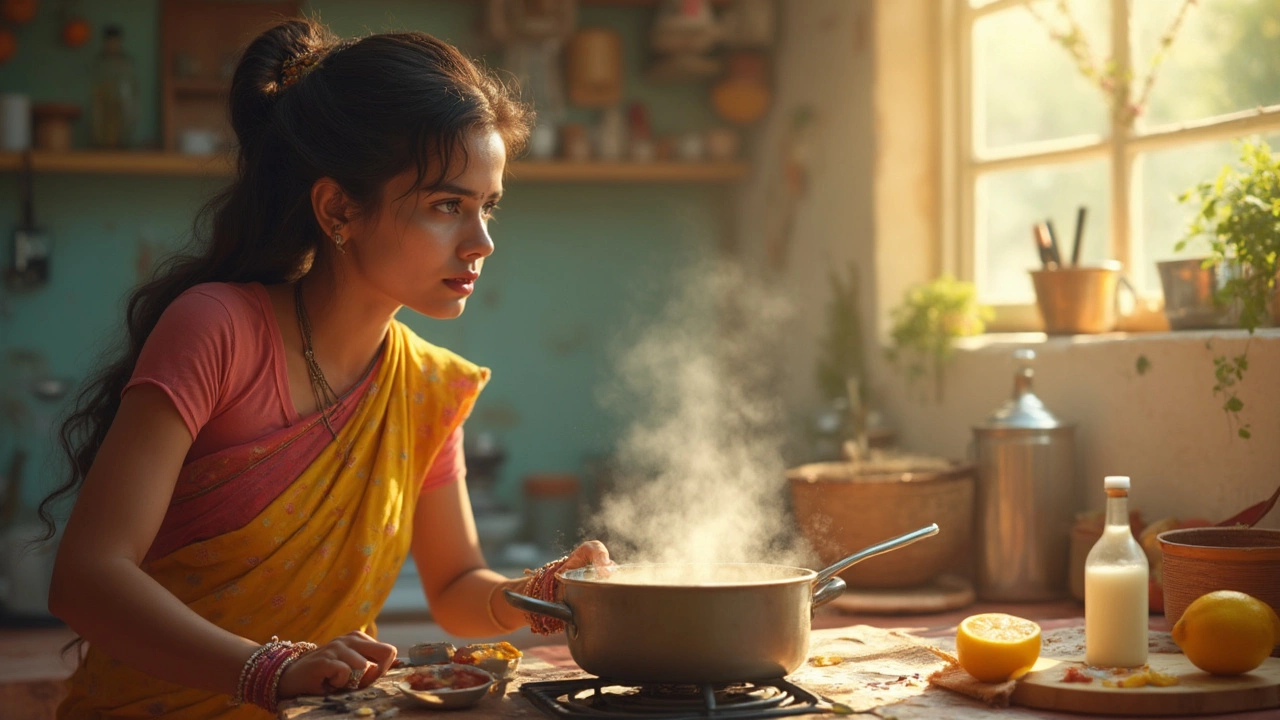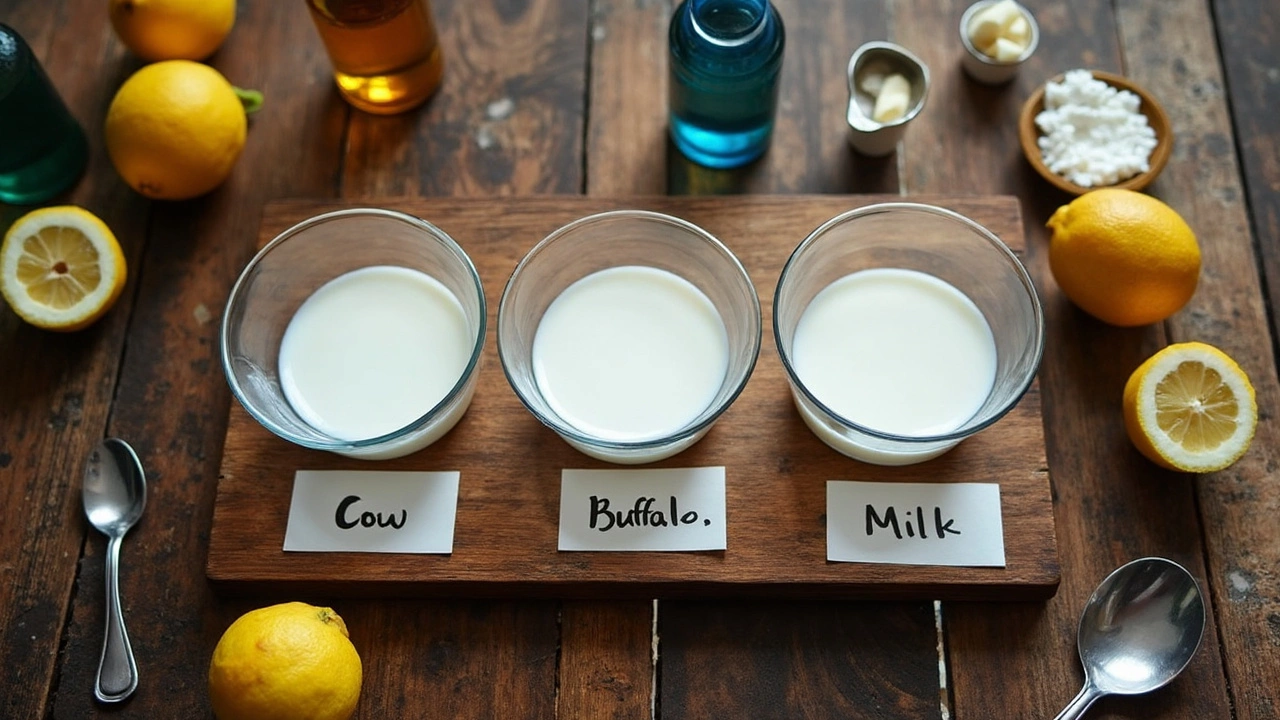What to Do If Milk Doesn’t Curdle for Paneer: Easy Fixes and Smart Hacks
 May, 10 2025
May, 10 2025
Nothing kills your paneer plans faster than milk that just sits there, doing absolutely nothing. You add lemon juice or vinegar, wait, and—no magic, no curds. If you’ve hit this wall, you’re not alone. This happens more than you’d think, even for people who’ve made paneer a dozen times.
Don’t throw out the milk yet! Most of the time, the problem is something simple—like the milk isn’t hot enough, or you’re using the wrong kind of acid. The tricks for fixing this are way easier than you might expect. You just need to know what’s going on, and how to nudge that milk into curdling the way it should.
Before reaching for new milk or giving up, keep reading. I’ve run into this kind of kitchen mess myself. There are solid reasons behind these fails and plenty of smart ways to turn runny milk into that perfect block of homemade paneer.
- Why Milk Sometimes Refuses to Curdle
- Fast Fixes When Curdling Doesn’t Happen
- Picking the Right Milk and Acid: What Works Best
- Bonus Tips for Fail-Proof Paneer
Why Milk Sometimes Refuses to Curdle
So, you’re staring at a pot wondering why your milk is just not budging. It’s not always your fault. There are some legit reasons milk sometimes refuses to turn into curds, and knowing them saves both your time and sanity.
The most common reason is the type of milk you’re using. If you go for ultra-pasteurized or UHT milk from the supermarket, that stuff is like Teflon for paneer making. High-heat processing zaps away the proteins that need to stick together for curds. Always check the label—regular pasteurized full-fat milk is your friend here.
- milk doesn't curdle sometimes because it isn’t hot enough. Milk needs to hit about 85-90°C (185-194°F) to curdle well. Anything less and you're just taking a warm milk bath.
- If you poured in lemon juice or vinegar and nothing happened, maybe you didn’t add enough acid. The ratio matters: aim for about 2 to 3 tablespoons lemon juice or vinegar for every liter of milk.
- Old or spoiled milk sometimes just turns sour on you instead of making proper curds. Fresh milk always gives much better results.
- Some folks use low-fat or skim milk and expect magic. Paneer loves fat. Skimmed or toned milk makes very little curd and it’s crumbly at best.
Here’s a little table to show some of the big troublemakers that leave folks stuck with runny milk:
| Reason | What Happens |
|---|---|
| Ultra-pasteurized Milk | Proteins won’t clump, no curds form |
| Low Temperature | Acid won’t work, milk stays liquid |
| Not Enough Acid | Partial curdling, cloudy mess |
| Low-fat or Skim Milk | Almost no paneer, crumbly curds |
| Sour/Old Milk | Off flavors, poor texture |
Knowing these roadblocks makes you way less likely to end up with disappointment in your pot. Fixing them doesn’t take much—just adjust your milk or your method and you’re back on track.
Fast Fixes When Curdling Doesn’t Happen
So your milk looks the same after you poured in acid? Don’t panic. This happens, usually for one of three reasons: temperature, not enough acid, or the wrong type of milk. The good news? There are quick, no-nonsense fixes for each one.
- Check the Temperature: Paneer needs the milk to be hot, but not boiling. If it’s not hot enough, the curds just won’t form. Aim for 90–95°C (194–203°F). A kitchen thermometer helps, but if you don’t have one, watch for a foamy layer on top and the milk starting to rise—right before it boils. If it cooled down while you were fussing over it, reheat gently and try again.
- Add More Acid: Sometimes, you just need more acid. Start with a tablespoon of lemon juice or white vinegar, and if nothing’s happening, add another tablespoon—slowly, with a gentle stir. Bottled lemon juice works in a pinch, but fresh lemons react faster.
- Switch Up the Acid: If lemon juice didn’t do the trick, try white vinegar instead. It’s a bit stronger and can prompt curdling instantly. Don’t mix acids, though. Pick one, add more, and wait two minutes before deciding if you need to switch.
- Let It Rest: This one’s underrated. After adding your acid, cover and wait 5–10 minutes. Sometimes curds take time, especially with organic milk.
Here’s a real quick reference for what usually works best (assuming you’re using full-fat dairy milk):
| Fix | Success Rate | Time to Curds |
|---|---|---|
| Reheat milk to 95°C/203°F | 90% | 1-2 min |
| Add an extra tablespoon of acid | 80% | 30 sec–2 min |
| Swap to white vinegar | 85% | 30 sec–1 min |
| Let sit covered after acid | 70% | 5–10 min |
If, after all this, you’re still staring at a pot full of milky liquid, double-check you didn’t grab UHT or ultra-pasteurized milk (it almost never works for milk doesn't curdle scenario in homemade paneer). Skim or fat-free milks also usually refuse to make decent curds. When in doubt, regular whole milk is your safest bet.
Remember, most of the time it’s just about heat and acid. Get those right, and you’ll be straining curds in five minutes flat.

Picking the Right Milk and Acid: What Works Best
Getting milk to curdle for paneer comes down to two simple things: the milk you use and the acid you add. If you mess up either, your milk doesn't curdle, and you’re left scratching your head instead of pressing fresh paneer.
Let’s talk milk first. Always go for full-fat or whole milk. That’s the stuff you want because it has more fat and protein, which means richer curds and a better yield. Skim and low-fat milks might save calories but are terrible for making paneer—they’re just too watered down. And watch out for ultra-high temperature (UHT) milk. The long shelf-life variety that doesn’t need to be refrigerated? That milk usually won’t curdle right even with the best acid. Pasteurized milk is fine, but UHT stuff has proteins altered so much they hardly react. If you can, get fresh, local milk or at least something labeled "whole milk" that isn’t UHT.
Now for acids. Lemon juice and plain white vinegar are classic options. Both work, but here’s the thing: vinegar is a little stronger and acts faster, while lemon juice leaves a milder taste in your paneer. You need about 2 to 3 tablespoons of acid per liter of milk. If you want a really subtle flavor, yogurt works too—just use double the amount you’d use for vinegar or lemon.
The real trick is adding the acid when the milk is just starting to boil—hot, but not raging. If you pour it in when the milk’s just warm, nothing happens. Too late, and you might scorch the milk. So, bring your milk up to a nice boil, turn off the heat, and stir in your acid slowly while mixing gently.
- Whole milk is king for paneer—skip low-fat and UHT.
- Lemon juice is milder, vinegar is fast-acting, yogurt is gentlest but slower.
- Add acid when milk is very hot, just off the boil.
- Stir gently—don’t go wild, or your curds will be tiny and crumbly.
If you follow these simple bits, you’ll see the milk separate into curds and whey. Still not working? Double-check your milk and your acid before blaming your luck. Most of the time, fixing one of those two solves everything.
Bonus Tips for Fail-Proof Paneer
If you’re tired of your homemade paneer falling apart or never even forming right, it’s time for some insider tips. Stop guessing and start getting it right every single time.
First, don’t use UHT (ultra-high temperature) or long-life milk. These are the biggest troublemakers for curdling because the high temp process zaps out nearly everything you need for milk doesn't curdle to turn into curds. Go for full-fat, fresh dairy milk instead. If possible, use whole cow’s milk straight from a local dairy, or at least pasteurized—not the shelf-stable boxed stuff.
Temperature really matters. Aim for 85-90°C (185-194°F). Grab a kitchen thermometer if you have one. Milk that’s too cool just sits there. If you heat it too much and it boils like crazy, your curds could turn rubbery. Right before boiling—when you see little bubbles on the side—that’s your cue.
Next up, don’t skimp on acid. If using lemon juice, you’ll need about 2-3 tablespoons per liter of milk. Vinegar or citric acid? Usually, 1.5 tablespoons is enough. Stir gently. Being too rough smashes the curds, and if you don’t stir at all, the acid won’t mix well. Gentle, slow circles work best.
- Always line your strainer with muslin or a thin, clean cotton cloth to catch the curds properly.
- Rinse the curds in cold water after draining. This stops the cooking and washes out any lemon or vinegar flavor.
- To shape the paneer, fold the cloth over and press it down with a weight (like a pot of water) for at least 30 minutes.
- If you want it softer, don’t press for too long. For super firm paneer, go up to 2 hours.
Here’s a quick look at how milk types and amounts of acid really make a difference:
| Milk Type | Average Paneer Yield (from 1L milk) | Ease of Curdling |
|---|---|---|
| Whole Cow's Milk (Pasteurized) | 180-200g | Easy |
| Buffalo Milk | 220-250g | Very Easy |
| UHT/Long-Life Milk | <100g (often fails) | Hard/Unreliable |
One last thing—a bit unusual but true—sometimes hard water in your tap can affect curdling. If you can, use filtered or bottled water when rinsing the curds and boiling your milk. It’s a small touch, but it can save your batch when everything else looks perfect.
Messing up once or twice is normal. With these tips, you’ll feel like a paneer pro in no time. Next time your friends ask for that recipe, you’ll have more than a few brag-worthy secrets to share.
